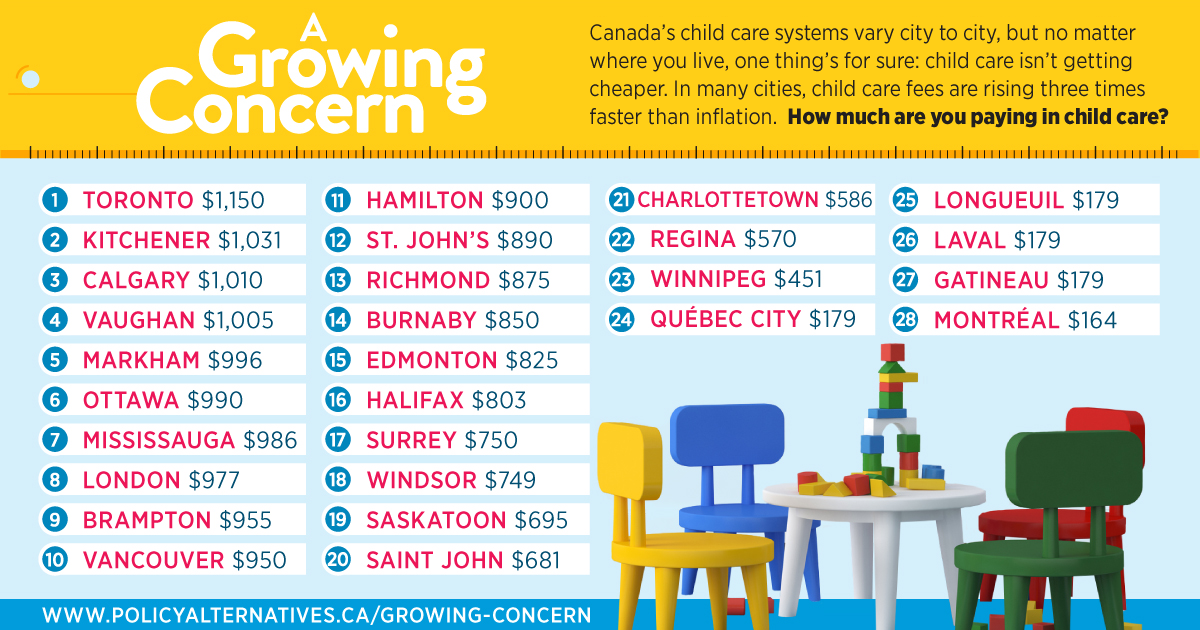It’s no surprise—to anyone with even a modest awareness of the subject—that child care is expensive.
But when we released our recent report (A Growing Concern: 2016 child care fees in Canada’s big cities), what did raise some eyebrows was the speed and intensity with which fees have increased over the past two years: on the whole, far more than we (and probably most others) expected.
In Canada, we spend a great deal of time talking about kids—how we love them, how we prioritize them, how we need to invest in them to ensure they are able to reach their potential. However, when it comes to putting policies in place to actually ensure that many of these outcomes are met, and that the families of those children are supported in the process, we fall short. And this has real, tangible consequences for kids, families and communities across the country.
There is no national system of public, universally-accessible child care in Canada. And here’s what that has meant for me, and for thousands of others, by the numbers:
4: number of months into my first pregnancy when my partner and I started calling to have our name placed on day care waiting lists in Ottawa.
11: age (in months) of our first child when we found a space.
300: number of names on the newly-established centralized Ottawa list in 2004.
10,000: number of names on the list in 2006.
2nd: where monthly child care fees ranked in our monthly household expenditures (slightly less than the mortgage, more than student loan repayments).
4.5: number of years between our two kids.
100%: likelihood that this time period was directly related to the costly combination of child care fees and monthly student loan payments (on top of other household expenses).
5%: increase in full-time incomes for men over the past 30 years.
35: minimum number of hours a week worked by 2/3rds of women aged 25-34 (up from less than ½ of that cohort 30 years ago).
4: hours of unpaid housework and unpaid child care work performed by women each day (on top of paid work).
170%: current household debt-to-income ratio.
500,000: current number of kids in Canada with 2 working parents and no child care space.
18,000: number of names on Toronto’s child care waiting list.
$1,649: average monthly fee for an infant space in Toronto (2016).
$164: average monthly fee for an infant space in Montreal.
2: number of times average yearly infant child care fees in Toronto are greater than annual tuition fees in Ontario.
$1,375: average monthly fee for a toddler space in Toronto.
$164: average monthly fee for a toddler space in Montreal.
$1,150: average monthly fee for a preschool space in Toronto.
$164: average monthly fee for a preschool space in Montreal.
$2.2 billion: increase to provincial government total revenue in 2008 as a result of Quebec's child care program.
8%: average increase in monthly child care fees since 2014.
2.5%: increase in inflation over the same period.
$15: average hourly wage for child care workers in Canada (approx).
70%: percentage of child care centres in the cities surveyed reporting a wait list.
47%: percentage of child care centres in Vancouver reporting charging a wait list fee.
$500: monthly out-of-pocket fee for low-income, subsidy-qualifying parents in Saskatoon and Calgary.
$90: monthly out-of-pocket fee for a subsidy-eligible family in Ontario (the lowest in the country).
3: number of provinces (Quebec, Manitoba, PEI) where fees are set by the government and base funding is paid to service providers.
$140,000: quick back-of-the-envelope calculations of our family’s child care expenses for two kids over 10 years.
Erika Shaker is Director of Education and Outreach at the Canadian Centre for Policy Alternatives. She tweets at @erikashaker.
Additional sources:







